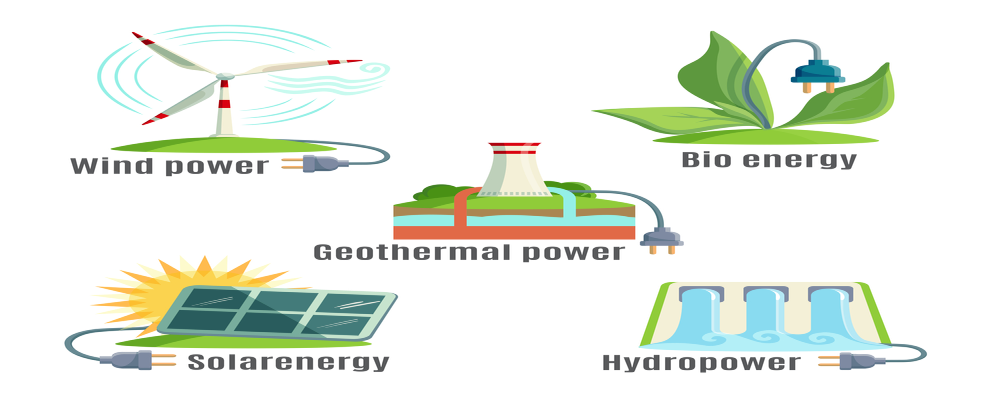What Are Viable Alternative Energy Sources?
To keep up with the increasing demand for electricity, more fossil fuels are burned, leading to a greater amount of carbon emissions that contribute to the planet’s temperature rise.
The world is already reeling from the impact of global warming. Extremes in weather, which causes raging wildfires, destructive hurricanes, and freezing snaps, is just one of the negative consequences of this unfortunate environmental event.
By slowing down the increase of the earth’s temperature, global warming can hopefully be kept at bay.
Conserving energy is one of the ways to delay the heating up of the planet. But with the increasing population, curbing electricity use alone can’t work for long. Looking for alternative energy sources is a more viable solution.
What Is Alternative Energy?

Alternative energy refers to power sources that don’t involve the use of fossil fuels, such as oil, coal, or gas. Fossil fuels are limited in nature, whereas alternative energy sources are naturally replenishing and are almost inexhaustible.
Because alternative energy comes from sustainable resources, they are a fuel option that can best replace non-renewable fuels.
Different Types Of Energy Sources
The use of alternative energy sources, also known as renewable energy, has gained tremendous ground in the U.S. owing to the many advantages these energy generators offer. Fortunately, there are several suppliers of renewable energy available to the world.
Solar Energy
Solar energy is one of the most popular types of alternative energy and for good reasons. Solar power comes from the sun, making it totally renewable. Solar panels, or photovoltaic (PV) panels, absorb the radiant energy of sunlight and transform it into electricity.
Solar power is an excellent electricity source. Because the sun will be around for many more years, the limitless supply of solar energy it provides can render fossil fuels obsolete.
It is also an outstanding source of clean energy, as the conversion of sunlight into electricity produces no carbon emissions. Solar power systems do not release particulates into the air, and they have minimal impact on the environment. As such, solar energy helps improve public health by reducing pollution, which is a leading cause of respiratory and cardiovascular issues.
Nuclear Power
Producing nuclear power involves releasing the energy inside the core of an atom in a process called fission. The released energy is harnessed in a power plant and is then used to generate electricity. Among the renewable energy sources, nuclear power remains one of the most controversial.
Hydroelectric Power
This alternative energy source comes from the force of flowing water. There are different ways to produce electricity from water, the most common of which is by damming rivers to store water in a reservoir. When needed, water can be released, which then flows through the dam’s turbines. The force of the water spins the blades and generates clean energy, which power homes and industries.
Hydroelectric power is a versatile form of renewable energy which can be produced through large-scale projects such as the Hoover Dam and through small-scale endeavors like placing turbines on small rivers and streams.
Electricity generation from hydropower topped the record for contributing the most power among the common alternative energy sources in 2020.
Biomass Energy
Biomass energy is renewable energy that comes from plants and animals. Biomass is the fuel that is derived from organic material, such as forest debris, scrap lumber, animal manure, and the like. Direct combustion, that is, burning the biomass fuels to produce heat, is the most common way of utilizing biomass energy.
Generating energy from biomass is cost-effective. Compared to using fossil fuels to produce electricity, it takes around 1/3 less to generate electricity from biomass.
It’s carbon neutrality is one of the most important benefits of this alternative energy source. Being carbon neutral means that plants absorb carbon from the atmosphere as part of photosynthesis. When plants decay, they release the carbon back to the air, which is then taken in by other vegetation.
As a result, biomass fuels release the same amount of carbon that they extracted from the atmosphere, so they don’t contribute to global warming, unlike fossil fuels.
Geothermal Energy
Geothermal energy comes from deep within the earth. The renewable energy source is the heat that’s contained in the rocks and fluids underneath the earth’s crust. Producing geothermal energy involves digging wells that go far down to the underground reservoirs of steam and hot water. The steam then drives the turbines that are connected to power generators.
Geothermal power is one of the more reliable types of renewable energy because it does not fluctuate the way other alternative energy suppliers do. This makes it easier to predict and calculate the output from a geothermal power plant.
Natural Gas
We’re not talking about natural gas that comes from fossil fuels but rather about natural gas from biomethane, a renewable energy source. Natural gas can still produce some greenhouse gases, such as carbon dioxide, but it is still cleaner than traditional sources of energy.
Biofuels
Biofuels are fuels that can be used for transportation needs. Unlike fossil fuels, biofuels are considered renewable sources of energy because they are created from organic matter. The most common biofuels are biodiesel and ethanol. The use of these biofuels lessens the consumption of fossil-fuel-sourced gasoline and diesel.
Hydrogen Gas
Hydrogen gas has the potential to deliver a tremendous amount of energy. Once produced, hydrogen gas can be used in fuel cells to produce electricity. However, this energy source is primarily created from fossil fuels for now, which could counteract the benefits its use offers.
The production of green hydrogen, or hydrogen that comes from renewable sources, is in the offing. Using green hydrogen won’t harm the environment, giving hydrogen gas a boost in ranking in the list of renewable energy to watch out for in the country.
Wave Energy
The sea is one of the earth’s sources of energy. The unceasing rise and fall of the ocean’s water create tidal energy or wave energy. Tidal energy can be captured and transformed into electricity. Unfortunately, although tidal energy can become a significant energy source, its use hasn’t been so robust due to certain limitations.
Wind Energy
In a technical sense, wind energy is a form of solar energy. This is because the wind is caused by varying temperatures in the atmosphere resulting from the uneven distribution of the sun’s heat on the earth’s surface.
Wind turbines in wind farms harness the energy created by the wind’s movement, otherwise known as wind power, and transforms it into electricity. A wind turbine does not emit greenhouse gases like nitrogen oxides, carbon dioxide, and sulfur dioxide into the air. Thus, being a clean source of energy is one of the benefits of wind energy.
Advantages Of Alternative Energy Sources

The various types of renewable energy offer many advantages. Let’s look into some of the major ones.
Renewable energy won’t run out: Because alternative energy sources can replenish themselves, the world will have a constant supply. Unlike fossil fuels, which can be depleted in around 50 years, renewable energy will remain abundant far into the future.
Alternative energy sources have a minimal environmental impact: Burning fossil fuels creates pollution and speeds up climate change by heating the planet. The use of alternative energy sources can help decrease pollutants in the air and retard climate change.
Harnessing renewable energy saves money: Renewable energy facilities usually need less maintenance, thus saving major bucks.
The Present Limitations Of Alternative Energy Sources
Unfortunately, alternative energy sources also encounter some hurdles. These include:
High initial cost: The technologies involved in setting up renewable energy sources can require a lot of green bucks. Moreover, renewables need to generate energy for many years before investors can see a return on their investment.
Unreliability: Green energy may be renewable, but the resources aren’t available 24/7. The sun doesn’t shine at night, and the wind doesn’t blow at the same intensity day in and day out.
Storage problem: Storage technologies for renewable energy can be expensive. Until the cost decrease enough, traditional power sources remain more viable options when it comes to storage.
Price Comparison Between Alternative Energy Sources And Fossil Fuels
One of the biggest challenges to the widespread adoption of renewable energy is the upfront expenses. From PV panels needed for solar energy to wind power technologies that will harness wind energy, the required cash outlay for setup is jaw-dropping.
However, renewables can pay for themselves over time, and there are various government subsidies that can soften the economic impact of the initial setup of these technologies.
But first, let’s take a look at the price of renewable energy compared with traditional power sources. To do this, we’ll use the price of electricity per kilowatt-hour coming from the use of fossil fuels vis-à-vis the different renewables.
The U.S. electricity rates coming for the various sources are as follows:
- coal plants- $0.12-0.13
- natural gas- $0.04.
- biomass- $0.09
- geothermal energy- $0.04
- hydropower- $0.04
- solar power- $0.04
- wind power- $0.04
- nuclear energy- $0.09
The Future Of Alternative Energy As Replacement For Fossil Fuel

In reality, the world has no choice but to shift to alternative energy sources. Not only because climate change had started wreaking havoc on the planet but because fossil fuels will eventually run out in the not-so-distant future.
Sustainable fuel sources exist, and barring the high initial cash outlay, these sources can provide power at rates lower than those coming from traditional ones. The challenge lies in how to drive down technology costs and ensure the reliability of renewable sources.
Slowly but surely, the world’s transition to alternative energy is progressing. In many areas of the country, where solar and wind energy is available, electricity from photovoltaic and wind power has been supplementing or even completely displacing electric power generated from traditional sources.
More solar and wind farms are being built, and the power they generate is contributing to the total electricity of the grid at an increasing scale. Out of necessity, clean energy will likely become the dominant source of electricity in the future.
FAQs
What is the most reliable energy source?
Nuclear power is considered the most reliable energy source. It has been supplying over 20 percent of the country’s power needs for close to six decades.
Nuclear power plants can generate maximum power over 93 percent of the time during the year. That’s 2 times more than natural gas and coal-fired ones and up to 3.5 times more than solar and wind sources.
What are disadvantages of renewable energy?
Despite the many benefits offered by renewable energy, using these power suppliers comes with some challenges. These are:
Limited capacity: For now, alternative energy generators can’t produce enough electricity to completely cover the world’s energy needs.
High setup expenses: The technology and infrastructure involved in renewable energy setup require a considerable sum.
Storage issues: Renewable energy tends to be intermittent in nature. As such, there’s a need for cost-efficient storage solutions, which, for now, are still in the developmental stage.
Geographic limitations: Owing to the diverse topography and climate of the country’s various regions, not all areas are suitable for certain renewable technologies.
What is the cheapest alternative energy source?
Among the different renewables, solar and wind are the cheapest alternative energy sources. The price of electricity coming from these two is closer to the power rates provided by traditional sources. Power generated by wind turbines costs around $0.06 per kWh on average, while that from solar PV systems comes to $0.10 per kWh. In comparison, electricity rates from conventional sources are at $0.05 to $0.17 per kWh.
Extensive research and continued developments in these renewables have led to declining prices, and the trend is expected to continue.
What is the most efficient clean energy?
Not only is wind power the cheapest alternative source of energy, but it is also the most efficient. Several factors determine the efficiency of an energy generator. Some of these are:
– How much electricity can be generated from the energy harnessed by the source
– The type of materials used and the expenses involved
– The environmental clearing needed to set up the infrastructure
Taking the following factors into account, wind energy topped the list. In addition, it is also the leading renewable energy source in the country as the use of wind turbines helps supply eight percent of the nation’s electricity needs.
Final Words
Alternative energy sources are not just here to stay. They will likely become the dominant suppliers of electricity in the coming years.
Despite the many hurdles facing renewables, they are the wiser choice, especially since the obstacles in their way are being conquered one by one. The cost associated with the setup and infrastructure development had been falling steadily compared to traditional fuel generators, which are becoming scarcer, and thus, more expensive. The different technologies are also experiencing increased efficiency owing to advances in scientific know-how.
In the end, it doesn’t matter which alternative energy source becomes the most dominant. What’s important is its benefits, especially to the planet that is being devastated by the effects of climate change.
Updated on
